1972
What Two Midshipmen Did During the Vietnam War
Another Link in the Chain, A Cold-Water Ephphany
What Two Midshipmen Did during the Vietnam War
This year, 2023, marks the 50th anniversary of the return of the American POWs from captivity during the Vietnam War. While the timely return of POWs from captivity after the end of the war is attributed to the tenacious political campaign waged by the wives of the POWs led by Sybil Stockdale, another campaign to support the families and children of the POWs while their fathers were imprisoned was conducted by two midshipmen at the U.S Naval Academy when the end of the war was in doubt. Read the entire story at this link.
Another Link in the Chain, a Cold-Water Epiphany
Ellis W. Merschoff ‘72
The Boston Light Swim (BLS) is named after America’s oldest lighthouse at the ocean entrance to Boston Harbor which marks the starting point for an annual swim into the harbor. It is the oldest open water marathon swim in the nation, calling itself the “Grand-daddy of American Open Water Swims.” Beginning in 1907, just 10 years after the first Boston Marathon was run, 2018 marked the Boston Light Swim’s 111th year. Like the Boston Marathon, the BLS is an internationally renowned race on many an amateur athlete’s bucket list, but unlike land marathons, where the distance is fixed by Pheidippides’ run to announce Greece’s victory over the Persians, a swim marathon distance can vary. A marathon swim is generally considered to be any swim greater than 10 kilometers (6.2 miles). The BLS course has remained a consistent eight miles over the years as it relies on several of the islands dotting Boston Harbor rather than temporary buoys to define the course. The swim complies with “English Channel Rules”, meaning no wetsuits, no swimming aides, and no intentional contact with the boat.
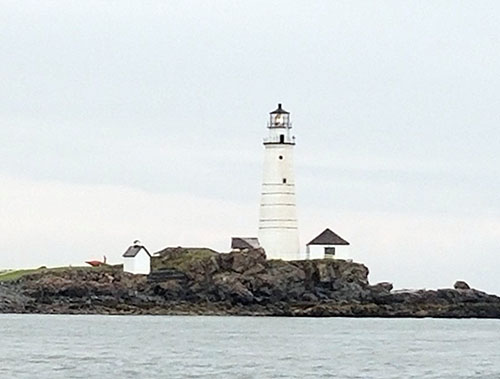
Boston Light, America’s First Lighthouse
Swimming eight miles from the Boston Light to the L-street beach in South Boston sounded like a good idea at the time I entered the lottery for one of only 22 solo spots available. But now, abeam of the lighthouse and ready to jump into what was promised to be a particularly cold year for a famously cold swim, I’m not so sure. It occurs to me I will be seeing the lighthouse rip-rap close up at water level, a perspective I spent my entire naval career successfully avoiding.
Fifty years and a lifetime ago, Coach Higgins cut me from USNA’s swim team barely six months into plebe year. What I did not realize at the time, but Coach Higgins did, is that I didn’t have a fast twitch fiber in my body. I could swim at hull speed forever but wasn’t quite able to get up on the plane like the real speedsters the coach needed. In time, I came to discover open water marathon swimming, where the ability to go long can often trump the ability to go fast.
At the sound of the starting horn, I jumped off the stern of our comfortably appointed cabin cruiser “Double Trouble” doing duty as my escort vessel for the day. I could barely manage to tread water and breathe as I came to realize just how cold this “cold-water swim” was going to be. I learned later the water temperature was 58 degrees, but in the moment all I knew for certain was this was the coldest water I had ever attempted to swim in. The starting horn had sounded at least a minute ago, my support crew onboard Double Trouble was encouraging me to swim, but I couldn’t swim and hyperventilate at the same time. Eventually, my breathing began to come under control and I started to swim, searching for the balance between vigorous enough to stay warm and easy enough to sustain for 4-5 hours. Stroke-stroke breath, stroke-stroke breath, man its cold. The voice in my head started to undermine my resolve, “You’re the oldest guy in the race by a decade; no one your age has ever finished the course in the allotted time; this water is dangerously cold, you can’t do eight miles of this…” But for the moment, I was OK, and managed to ignore the voice.
Swimming as in running marathons, provides plenty of time to think. Thankfully, my inner voice used this time to marvel at the surroundings rather than to continue to harp on the likelihood of success. “Hey, that’s Boston Light, originally build in 1716 and upgraded to its present form in 1783. That means the giants of Naval history, John Paul Jones, Decatur, Perry, Hull, Farragut and others used this very lighthouse to guide their frigates into Boston. Talk about another link in the chain…” My inner voice was informed by my interest in the history of the area and by my class’ role in fulfilling its “Another Link in the Chain ” responsibilities with the class of 2022. Had this tradition existed for my class, the class of 1922, a pre-World War II class 50 years our senior would have been our sponsors. I can only wonder how I would have received the offer of mentorship from men who had served in such a different time. In time I have come to realize that seamanship and leadership are timeless, and those old guys would indeed have had something to offer if I had been smart enough to listen. As a member of 11th company, we would occasionally host a member of the class of 1911 at evening meal. Unfortunately, we rarely probed those old timers for the lessons they had paid for dearly. A missed opportunity we can never get back.
Two miles into the swim, I am abreast of St Georges Island and have settled into a comfortable rhythm. The powerful current pushing the ocean and its swimmers into Boston with the incoming tide have made these first two miles very fast. Glancing to my left I notice a large red nun buoy and can’t help but recall, “Red to the right when returning from sea”. So, as long as I keep the red buoys to my left and ships keep them to their right, I will remain outside the channel and safely separated from the busy marine traffic. I’m beginning to think that maybe I can do this. I had come to the race confident in my training, but that confidence was eroded when the race director told me that if I finished, at 68, I would be the oldest person to ever complete the course in its 111-year history. It was easy to talk about doing this swim, but at some point the talking stops and the doing starts. Well, I’m doing the doing, and so far, so good.
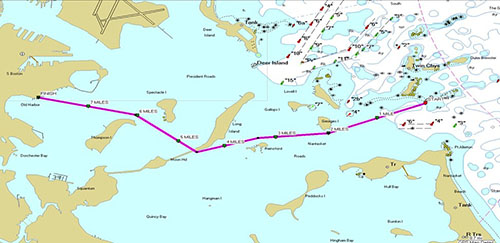
The BLS course is defined by Islands
Returning to the Baltimore-Washington area almost forty years after graduation facilitated my reconnecting with the academy. My wife Sherry’s decision to designate the swim team as the recipient of our Blue and Gold Society donations resulted in Coach Roberts’ reaching out to thank us for thinking of the team. After telling him of my interest in marathon swimming, he invited me for a long swim in the new (to me) Nimitz Hall Aquatic Center. Swimming in the Academy’s pool under the watchful eye of the coaching staff had my 60+-year-old self feeling a lot like my 18-year-old self who, back in 1968, was working hard to impress the coach. Here is yet “another link in the chain”. The lasting relationship with coaches and staff continues to shape the leaders we will or have become. Coach Roberts was picking up where Coach Higgins left off, encouraging and supporting a lifelong interest in swimming and fitness.
An hour into the marathon swim I stop to drink some Gatorade and obtain a dollop of Vaseline to soothe some chafing. The Gatorade goes down fine but the viscosity of Vaseline in cold water is considerably higher than I expected, creating difficulty in applying it to the required locations. It tended to lump-up, rather than spread easily. I also managed to smear the lenses of my goggles with the viscous goo which considerably hampered my ability to see the navigational landmarks. The thin coating of Vaseline on my hands hardened in the cold water making it feel like I was wearing gloves, taking away my ability to feel the water. The negative voice in my head was back, telling me “you can’t afford mistakes like this, you should have greased up wearing rubber gloves before you jumped in, that was the plan, but in the excitement of the start, you forgot. What else did you forget…” In response, I forced a change of subjects, getting my inner voice to recall and recite the relevant Laws of the Navy:
“Now these are the laws of the navy, unwritten and varied they be, and those that are wise will observe them, going down in their ships to the sea... ”
“Upon one link in the cable, dependeth the might of the chain. Who knows when thou mayest be tested, so live that thou bearest the strain.”
The endurance athletes among us are well aware that your mind can go to some pretty strange places over the course of a long race. For me, singing the laws of the Navy is a long way from the strangest, but the “another link in the chain” theme was stuck in my head, and this was where it took me on this day.
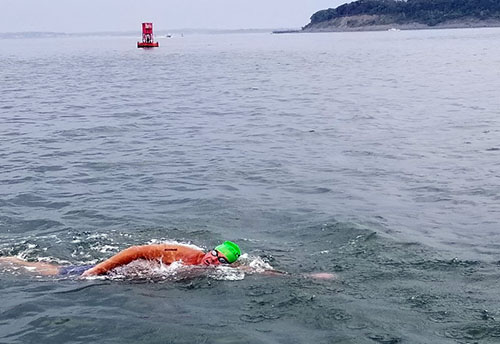
Swimming just outside the channel in the cold but relatively calm conditions
At three miles, approaching Rainesford Island, I begin to catch glimpses of the ruins of a bridge that once spanned the gap from Long to Moon Islands marking the halfway point of the swim. Swimming close to the ruins of a bridge would ordinarily make me uneasy, suspicious of debris hiding just under the surface, but in this case there was the possibility of warmer water at the shallow end of the bridge. Sure enough, the water temperature in the high 50s gave way to the low-70s, providing a much-needed replenishment of my core heat reserves. However, along with the warming comes painful cramping in both calf muscles. Whenever I point my toes to kick, cramps tie my leg muscles into knots. The solution is to just let the legs trail along, hitching a free ride from the arms. Being a mostly front-wheel drive swimmer, my kicking does little more than keep my legs from sinking. In fact, this was one of Coach Higgins’ chief complaints, “Come on Ellis kick, you saving those legs for something special?” I probably should have listened to that tip. Nonetheless, I can make his work. Stroke-stroke breathe, stroke-stroke breathe.
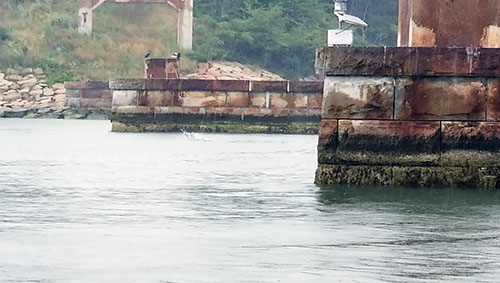
The Long Island to Moon Island Bridge Ruins
After clearing the bridge ruins and returning to a more central course just outside the main channel I can see the gap between the final two islands, Spectacle and Thompson. Unfortunately, the incoming tide is known to eddy around Thompson Island providing a contrary current that can significantly slow a swimmer’s progress. At the tip of Thompson Island, with the Boston Skyline and race finish line only two miles distant, I hit the full force of the contrary current. Spectacle and Thompson Islands, the Scylla, and Charybdis of the BLS are well-known hazards, best taken down the middle. Somehow this warning, so clearly stated at the pre-race meeting, was forgotten or ignored, and now I find myself firmly in their grip. My legs no longer feel like a part of me due to the cold exacerbated by the lack of kicking. Nonetheless, I give my legs a pep talk, attempting to recruit them to the effort. I was apparently successful, as they once again began to contribute to the effort and help to slowly break free from the monsters’ grasp. With the final hurdle cleared, the end was in sight, yet still a mile distant. As I try to relax and maintain a constant pace to carry me through the final mile, I begin to feel very cold. It seems recruiting my legs back onto the team resulted in some pretty cold blood returning to my core from its hiatus in my heretofore freeloading legs. I had not felt this cold since first jumping in, but the prospect of actually finishing kept me going. With about a quarter mile left, my support team congratulated me and pointed me toward the finish. Ignited by hope, I powered through the last few yards to a warm reception at the finish line.
I was the twelfth person to finish, well under the five-hour limit, setting a new record for the oldest person ever to finish the race. Of the 22 solo swimmers, two reached their personal limits and withdrew during the swim while five continued swimming until the five-hour time limit was reached and the order given to board their escort vessels. These folks referred to collectively as 5-hour swimmers, earned the respect of all participants since continuing to move forward for five full hours in very cold water is every bit as challenging as finishing the eight-mile course.
Like so many things in my life, this particular success has roots in my academy experience. Coach Higgins gave me one of my first lessons in leadership when he recognized my strength (endurance), while explaining his needs (speed). Making a tough decision while showing respect for the person involved was a lasting lesson for me. Then, decades after graduation, having Coach Roberts reach out to me and offer help was another lesson in leadership, and the value of maintaining the links in the chain. Finally, as the class of 2022 begins defending the long and proud tradition of Navy Swimming, the class of ‘72 has an opportunity to reach out as “another link in the chain” to pass on the best of our lifetimes of learnings relative to leadership and life; lessons that are immune to the passage of time. The challenge, of course, will be in convincing the class of 2022 that a bunch of old Vietnam-era alumni have something meaningful to offer. Ex Scientia Tridens.
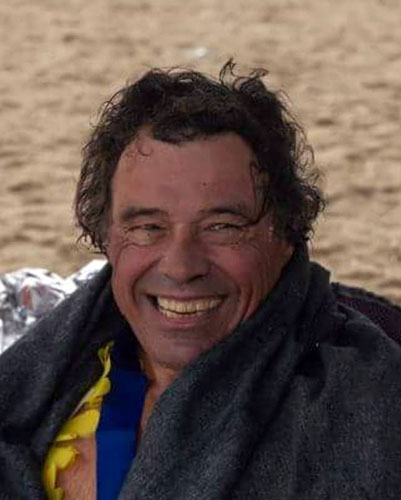
Happiness is finishing the BLS